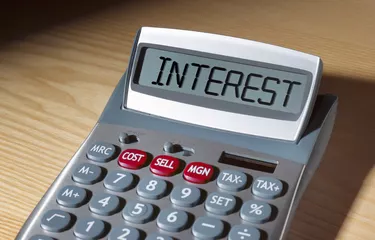
When dealing with forward and futures contracts, calculating the implied interest rate is a necessary step in assessing the rate of returns across assets. Whether you deal with exchange rates, commodity prices or stock prices, you may need to calculate the implied interest rate. If you have a financial advisor, they may be able to assist you in determining the implied interest rate on your assets. This concept can be a bit complicated for novice investors to calculate on their own.
What Are Implied Interest Rates?
Video of the Day
An implied interest rate conveys the difference between a forward/future rate and the spot rate. It's used most often when comparing returns across multiple assets and situations involving a forward or futures contract.
Video of the Day
When calculating the implied interest rate, the three values to know are the forward or future rate, representing the expected future value of the asset; the spot rate, which is the asset's current market value; and the amount of time until the contract matures.
A positive implied rate indicates that future borrowing rates will increase. Conversely, a negative implied rate means that future borrowing rates will decrease.
What Are Forward and Futures Contracts?
Implied interest rates are most often used any time a forward or futures contract is involved. Investors use both contracts to hedge against risks by locking a specific price for an asset in place. While very similar, there are a few differences in terms of when each contract is used. Forward contracts are used to ensure the buying or selling of a specific asset at a set price, known as the forward price, and at a specified time, known as the contract maturity or expiration date.
While similar, futures contracts, more commonly referred to as "futures," are settled daily, not at maturity. This allows futures to be bought or sold at any time. According to the team at the Commodity Futures Trading Commission (CFTC), most futures are liquidated prior to contract maturity. Futures also differ from forward contracts in the parties who make them. While forward contracts are private agreements made between two parties, futures are traded on public exchanges.
Used in trading, futures are agreements between individuals or corporations to buy or sell a specific commodity at a future date, most often between hedgers and speculators, or those who profit from price changes in futures contracts, the CFTC writes. In a futures contract, the commodity price and amount are fixed at the time of the agreement. Additionally, some contracts allow a cash settlement instead of delivering the commodity.
Calculating Implied Interest Rates
Once you have the forward/futures, the spot rate values and the length of time, you can calculate the implied interest rate. The formula is as follows:
Implied Rate = (Forward or Futures rate / Spot rate)1/Time - 1
For example, suppose you're calculating the implied interest rate on a stock that is currently trading for $100 and have a forward contract trading at $150 with a two-year maturity. The values for the equation are as follows: the forward rate is 150, the spot rate is 100 and the time is 2.
Implied Interest Rate = (150/100)(1/2) - 1 = 22.5%
Divide the futures rate of 150 by the current spot rate of 100. Since the contract matures in two years, raise the value to the power of 1/2, since the formula calls for 1 to be divided by the amount of time. Finally, subtract 1 from the value to find the implied interest rate.
Consider also: Definition of Implicit Interest Rate